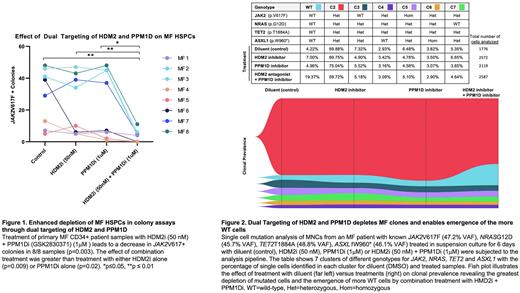Abstract
Dysregulation of TP53 in myeloproliferative neoplasms (MPNs) has been hypothesized to be a key driver of disease progression (Kubesova et al, Leukemia. 2018;32 (2):450-61). Targeting of double minute protein 2 (HDM2), a negative regulator of TP53, results in activation of the TP53 pathway which induces cell death in hematopoietic stem and progenitor cells (HSPCs). Nutlins, antagonists of HDM2, are currently being evaluated in multiple MPN clinical trials with promising results to date. Protein Phosphatase Mg2+/Mn2+ dependent 1D protein (PPM1D) is another key negative regulator of the TP53 pathway that dephosphorylates TP53 and stabilizes HDM2 (Hsu et al. Cell Stem Cell. 2018 Nov 1;23(5):700-13). We and others have previously reported the presence of PPM1D mutations in MPNs that result in overexpression of the protein (Grinfeld et al, N Engl J Med. 2018 Oct 11;379 (15):1416-30). We have also reported overexpression of PPM1D in the mononuclear cells (MNC) of a subset of MPN patients not harboring PPM1D mutations. We hypothesize that inhibition of PPM1D in myelofibrosis (MF) would target the MF HSPC and sensitize MF HSPCs to HDM2 inhibitors resulting in further depletion of MF HSPCs.
To further characterize PPM1D expression in the MF HSPC compartment, we utilized quantitative real time-PCR, to assess PPM1D transcript levels in CD34+ cells from 28 MF patients and compared these transcript levels to levels in CD34+ normal control cells (n=6). Forty-three percent (12/28) of the MF samples had overexpression of PPM1D (>1.5 fold increase) and the fold increase ranged from 1.8-59.
To identify whether PPM1D is a viable therapeutic target for MF HSPCs, we utilized hematopoietic colony assays to test the activity of GSK2830371, an allosteric inhibitor of PPM1D (PPM1Di) alone and in combination with a low dose HDM2 inhibitor (HDM2i). Eight samples from distinct MF patients were tested under these conditions. There was not a significant reduction in the number of JAK2V617F+ colonies upon treatment with single agent HDM2i (50 nM) (p>0.05) or PPM1Di (1uM) (p>0.05). Combination of PPM1Di (1 uM) + HDM2i (50 nM) resulted in decreased JAK2V617F+ colony formation in all 8 samples (p<0.005) (Fig. 1). The reduction in JAK2V617F+ colony number was significant compared to either single agent treatment with HDM2i (p<0.001) or PPM1Di (p<0.05) (Fig. 1). Four samples had persistence of or an increase in JAK2 wild-type (WT) colony number with combination treatment. The MF samples utilized were from a heterogenous population of patients that all had WT TP53 and PPM1D but included patients with high risk myeloid mutations (in ASXL1, NRAS), complex cytogenetics and prior exposure to standard MF directed therapies. Additionally, to validate the on-target effect of PPM1Di, we showed that treatment of leukemia cell lines with PPM1Di led to increased protein levels of phosphorylated-p53 and p21 and resulted in decreased viability and increased apoptosis.
To determine the effect of PPM1Di +/- HDM2i on distinct subclones we employed a multi-omics approach that allows for single cell mutation and epitope analysis of a clonally complex patient sample. We analyzed MNCs from a JAK2V617F, NRASG12D, TET2T1884A, ASXL1W960* MF patient treated in suspension culture with PPM1Di (1uM) alone, low dose HDM2i (50 nM) alone and PPM1Di (1uM) + low dose HDM2i (50 nM) in combination. Compared to vehicle alone or either drug alone, a marked effect was seen with the combination approach whereby the percent of WT cells increased by nearly 5 fold (4% to 19%) and 4/6 mutated clones were decreased in size, demonstrated by the fishplot (Fig. 2). These results show that the combination of the HDM2i + PPM1Di depletes multiple MF clones, while allowing for the emergence of more WT cells. Furthermore these studies demonstrate the utility of single cell genotyping to evaluate the effects of novel therapeutic strategies on MF clonal architecture.
These studies indicate that PPM1Di sensitizes MF HSPCs to an HDM2i and is a promising strategy to treat MF patients. To this purpose, we are currently developing a novel clinical grade PPM1D targeting agent. Dual targeting of PPM1D and HDM2 has the potential to further deplete multiple MF HSPC clones while allowing the persistence of WT cells. Additional combinatorial mutation + epitope studies are underway to determine degree of MF HSPC subpopulation depletion utilizing this treatment strategy.
Disclosures
Chen:Regeneron: Current Employment. Sebra:VP of Technology Development at Sema4: Current Employment. Hoffman:Protagonist Therapeutics: Consultancy; Novartis: Other: Chair DSMB; Repare: Research Funding; Novartis: Research Funding; Silence Therapeutics: Consultancy; Scholar Rock: Research Funding; Abbvie: Other: Chair DSMB, Research Funding; Ionis: Consultancy; Turning Point: Research Funding.
Author notes
Asterisk with author names denotes non-ASH members.


This feature is available to Subscribers Only
Sign In or Create an Account Close Modal